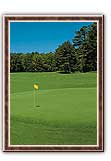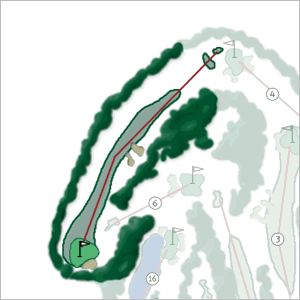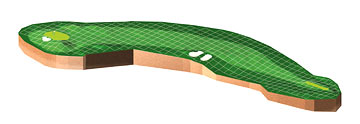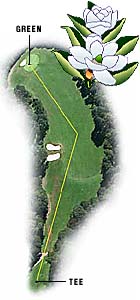| Hole Names | |
|
|
|

Hole #5MagnoliaMagnolia grandiflora Par 4, 435 Yards |

|
||
|
An uphill, dogleg left hole with a sloping green. Golfers favor hitting tee shots left, enabling a shorter second shot, but short of the ideal drive are two fairway bunkers. The green slopes down to the front, and a back bunker catches balls hit too long. Drive is across a valley to an uphill landing area on the slight dogleg left. Green is open at front, allowing a run-up approach to a two-level green. Drive is across a valley to an uphill landing area on the slight dogleg left. Green is open at front, allowing a run-up approach to a two-level green. The trick here is to bounce your approach shot onto the green, allowing the ball to stop on the upper level where the pin is always placed. Placing the ball on the lower level that collars the front of the green can leave some unbelievable putts. | |||

QuickTime AVI (5.01M) Animated GIF | |||
|
Jack Nicklaus says: Try to favor the left side of the fairway. That gives you the best angle. Here, a left-to-right iron shot is much preferred to a right-to-left shot, and obviously the selection of the right club is absolutely imperative here. The tee shot here isnít the problem, although itís a plus if you can turn the ball over around the corner. Itís the second shot and the green that make this one of the toughest par 4s we face. The tighter you can keep your drive to the trees on the left, the better your angle into the green, but flirting with those trees can be dangerous, so you donít want to get too greedy. Iíve seen plenty of players lose a few strokes in those woods. The advantage to playing it to the left side is that you are going to have more green with which to work. I always play a fade into this green, but there are times when the wind conditions force you to run it in there. I believe thatís how Bobby Jones and Alister Mackenzie designed itóto force you to fade the shot in or run it into the green. The best miss is still short right. Even though it creates a difficult putt, you shouldnít make more than 5 from there. This green looks big, but in reality it has one of the smallest playing areas Iíve seen. Iíll never forget 1995, when I had a pair of eagles here. In the first round, I hit a 5-iron into the middle of the green that rolled in. On Saturday I knocked in a 7-iron for my second 2. Fuzzy Zoeller says: It looks boring to most people, but this is a very good par-4 hole. It's 225 yards off the right edge of the fairway bunker. You have about 160 to 185 yards to the hole, but the green is deceiving. It's elevated about 3Ĺ feet from the front edge to the back. Tiger Woods says: I normally hit driver up the right side, depending on the pin location. If it's on the right side, I try to hug the left, but there's a bunker off the tee that the players have to contend with. Probably the most severe green on the golf course. If you're short, you'll roll back, but then as you go over the slope, it runs away from you. There's not a flat spot on that green. Anytime you make 4 there you're very happy, and making birdie is like stealing one. Fred Couples says: If you hit a drive down the left ,it probably plays 30 yards shorter. It's a little dog-leg left. I hit a driver and an 8-iron, and if I leave it out to the right, I'll have a 5- or 6-iron to a green -- as everyone knows it's a big green -- and you try to hit to one spot, the middle of the green. You don't try and get too cute there. You're basically trying to hit a shot away from the pin and hopefully have a birdie putt. Bernhard Langer says: Masters galleries will see a lot of players leaving this green shaking their heads in frustration after making bogeys. In fact, I would rank the fourth and fifth holes as the two hardest holes on the first nine. Off the tee, your drive needs to draw around the corner, leaving you as much as a 2-iron to as little as an 8-iron to the green. It's one of the hardest to hit at Augusta National. Personally, the iron shot is the most difficult one I face all week because I don't hit the ball high and I don't put as much spin on the ball as many other players. The green is 35 yards deep but the first 10 yards or so are an upslope. If you place your approach there, you usually roll back off. A more realistic way to look at the green is to think of it as being 12 yards deep on the left and 20 yards on the right. You just don't have much room. Once you get over the green's first ridge, the putting surface slopes toward the back bunker. The safest place to hit your approach is the middle of the green. If you're going to miss the green, keep it short or right. I birdied here in 1985's final round so I was very happy with that.
| |||

Hole #5MagnoliaMagnolia grandiflora The magnolia is one of the most prominent native trees at Augusta National. The botanical name Magnolia grandiflora is descriptive of the massive evergreen tree with large fragrant white flowers which bloom in May and June. Deciduous imported varieties are also present. |

|
||
fatpat Software · PO Box 1785 · Charlottesville, VA 22902 · (804) 977-1652
